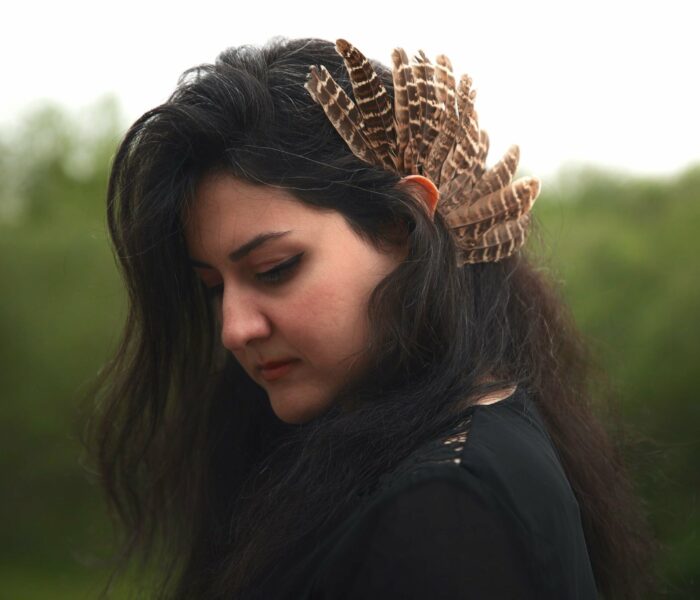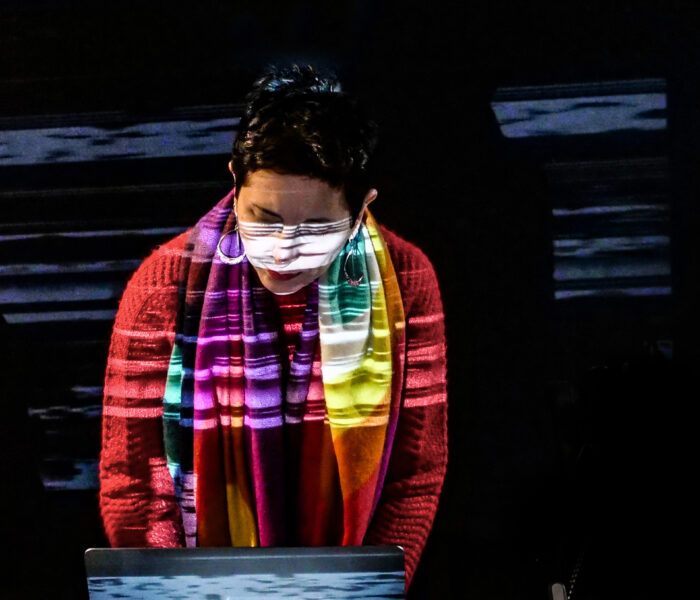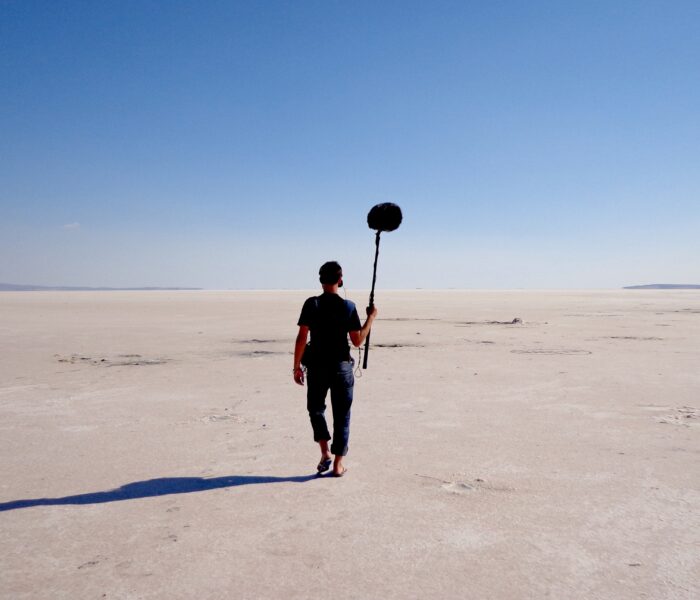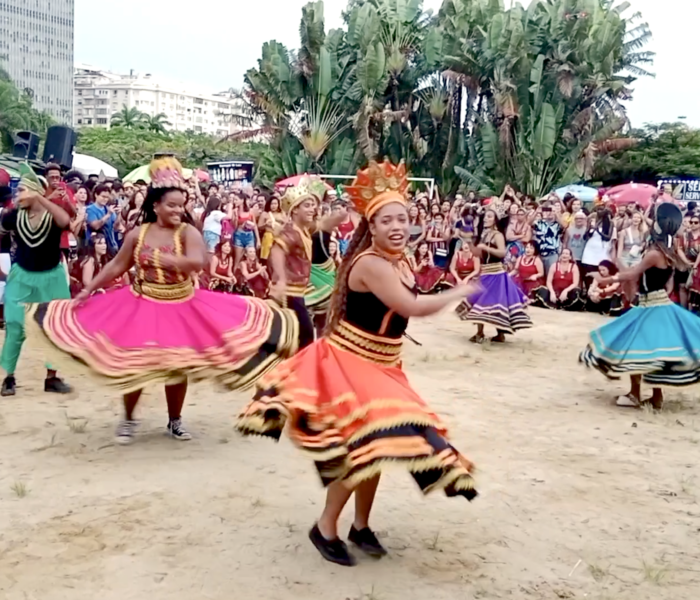Musicienne, compositrice, et musicologue, Youmna Saba s’empare des relations entre la musique électronique, électroacoustique et la langue arabe chantée. Elle est lauréate de cette première résidence sonore du musée du quai Branly qui s’inscrit dans un projet plus vaste en cours de conception, le Musée Résonnant qui verra le jour en 2024. À l’occasion de la présentation du projet du 23 au 25 mars sous forme d’exposition, de conférence et de concert, rencontre avec l’artiste, Christine Drouin, Directrice du développement culturel du musée et Éric de Visscher, conseiller scientifique en charge de la préfiguration et de la mise en œuvre de ce programme de valorisation du son dans le musée.
Son projet intitulé La réserve des non-dits, fait entendre les micro-sons à l’œuvre dans la tour des instruments de musique, réserve visible qui, sous la forme d’une tour de verre, traverse verticalement tous les espaces du musée. À travers l’écoute intime des sons qui sont produits en temps réel dans la réserve, par la simple vibration des instruments, Youmna Saba veut nous montrer que malgré leur « état passif » ces objets sont encore en vie. Il s’agit de penser les instruments comme des espaces de résonance en créant les conditions d’une écoute attentive des événements sonores qui sont à l’œuvre dans la réserve. Elle nous propose à la fois une installation sonore, une série de compositions, et l’état de ses recherches autour de trois lieux : la tour des instruments, le plateau des collections et la boîte à musique.
Avant d’interroger Youmna Saba sur son projet de résidence, il me semble important que l’on évoque ensemble ce qu’est ce projet de Musée Résonnant.
Christine Drouin : Le projet du Musée Résonnant est destiné à valoriser ce patrimoine immatériel, notamment les sons, en particulier sur le plateau des collections. Un projet à plusieurs entrées sur lequel Eric de Visscher nous accompagne et dont les résidences sonores font partie.
Eric de Visscher : Plusieurs sources nourrissent cette réflexion. Une réflexion un peu générale, celle que le musée n’est pas seulement visuel mais multisensoriel. En effet, l’on peut percevoir les œuvres non seulement par le regard, mais aussi par les autres sens. Cela s’applique évidemment au quai Branly car beaucoup d’objets sont en soit déjà des objets multisensoriels : ils proviennent de cérémonies, de rites où l’ensemble des sens sont appelés. Une autre spécificité de ce musée est son architecture. Il n’est pas constitué de salles successives mais conçu plutôt comme un territoire où le visiteur arpente des espaces de tailles et de volumes très différents et donc d’acoustiques diverses. Ces paramètres physiques particuliers nous ont permis d’aller un peu plus loin. À commencer d’ailleurs par ce silo d’instruments qui est à la fois une œuvre et une très belle idée, mais qui n’a pas été poussée jusqu’au bout et qui génère encore aujourd’hui peut-être plus de questionnements qu’il n’apporte de réponses. J’ai donc été immédiatement séduit par l’idée de Youmna de travailler autour du silo.
Il y a aussi la question du plateau, des collections où quelques points sonores sont présents déjà à certains endroits, mais inégalement répartis et de manière un peu illustrative, c’est-à-dire : “ je vous montre une flûte et vous fais entendre le son de cette flûte (ou d’une autre un peu équivalente en fonction des sources qu’on peut trouver)”. A ce stade de la réflexion, l’idée est d’abord d’ajouter des sources pour créer un contexte sonore plus homogène. On pourrait parler d’ambiance sonore, même si ce n’est pas tout à fait cela. Si on veut éviter le terme d’immersion, très galvaudé actuellement, je parlerais plutôt de l’idée de créer un paysage sonore.
CD : J’aimerais souligner que ce projet de Musée Résonnant a impliqué l’ensemble des équipes du musée à la fois les conservateurs, l’équipe du développement culturel et des expositions, les équipes techniques, le bâtiment. Nous avons fait une étude acoustique pour savoir comment ce bâtiment réagit à la question du son, ainsi qu’aux nuisances sonores. Nous avons aussi mené des expériences sur les perceptions des sons du musée par et avec le public. Ce qui est amusant, c’est que le public a l’impression d’entendre des sons là où il n’y en a pas! Sans doute imputable à la scénographie et l’architecture de Jean Nouvel, favorable à la dimension imaginaire de certains espaces, comme dans le jardin extérieur.
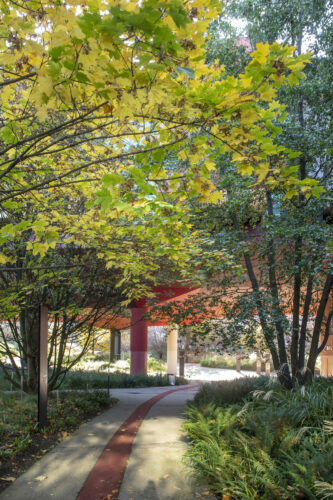


Le visiteur aura t-il la possibilité de visiter le musée selon différentes entrées, visuellement et par le son?
EDV : Oui, différentes entrées vont coexister, sans casque ni interactivité, mais de manière continue. Continu ne veut pas dire qu’il y ait une diffusion du son tout le temps et partout. Nous ménagerons des périodes de silence. Il y aura des sources sonores hautes ou basses, proches ou éloignées du public, comme lorsqu’on se promène dans une rue ou dans une forêt. Auquel s’ajouteront les regards que porteront les artistes sur une collection dans le cadre de résidences.
Est-ce un défi?
CD : Oui et non. La proposition de Youmna a pris une forme de l’ordre de l’exposition. L’installation de Youmna est en place jusqu’au 31 décembre. Or le parcours du Musée Résonnant ne sera en place qu’en 2024. Rien ne dit que le ou la résident.e sonore choisi.e cette année-là proposera un projet visible ou audible sur le plateau des collections. Les futurs résidents pourront choisir de travailler à partir des fonds sonores et audiovisuels du musée, d’intégrer des sons de nature captés par eux-mêmes ailleurs. Cela pourra prendre la forme d’une performance au théâtre.
Pourquoi avoir choisi de vous associer plutôt au Fresnoy – Studio national des arts contemporains qu’avec des Centres Nationaux de Création Musicale?
CD : Évidemment, le critère de sélection est le son et l’expérience sonore, mais il peut y avoir une ouverture sur le visuel. Et avec le Fresnoy, il y a eu immédiatement une volonté de travailler ensemble. L’histoire d’Alain Fleischer avec Jean Rouch a joué aussi dans ce sens.
Youmna, votre installation sonore La réserve des non-dits prend place dans la tour des instruments de musique et se déploie aussi dans deux autres espaces : la boîte à musique et le plateau du musée. De quelle manière avez-vous pensé et conçu ce projet?
Youmna Saba : La première fois que je suis venue en 2019, je n’avais pas remarqué la tour d’instrument. C’est à la lecture du dossier de résidence que j’ai pris connaissance de son existence, et je suis retournée au musée pour la découvrir. Mais on arrive assez difficilement à voir ce qu’il y a à l’intérieur, le visiteur ne pouvant y accéder. J’ai commencé à me poser des questions sur ces instruments : qu’est-ce que l’idée de conservation ? Est-ce que ce sont encore des instruments puisqu’ils ne sont pas joués ou deviennent-ils de simples objets? J’ai construit mon projet autour de cette question et de l’intuition qu’il y a sûrement quelque chose qui se passe à l’intérieur comme des phénomènes sonores très subtils. J’ai exploré cet espace comme un écosystème, lié à la conservation (la température, le taux d’humidité, la lumière) et à l’écoute, comme un environnement naturel en faisant des enregistrements à l’intérieur.
Lors de la première visite, j’ai approché un micro (pas très professionnel) près de l’embouchure d’une flûte et des harmoniques très belles se sont révélées. Et j’ai continué de procéder de la même manière durant trois semaines. Comme je ne pouvais pas toucher aux instruments, ni les déplacer, j’ai choisi des micros très petits, non intrusifs pour les insérer très délicatement et enregistrer leurs sons. À partir de cette importante collection d’enregistrements, j’ai fait une présélection, puis de l’editing au Studio national des arts contemporains du Fresnoy. On a créé une banque de sons qui sera en accès libre comme matière de création, de composition, voire même de réflexion, car beaucoup de détails et d’informations nous sont révélés par ces enregistrements. Puis, nous avons répartis trois points d’écoute sur les vitres du silo pour que des sons soient déclenchés en live par le visiteur·trice lorsqu’il·elle pose sa main sur une petite icône.
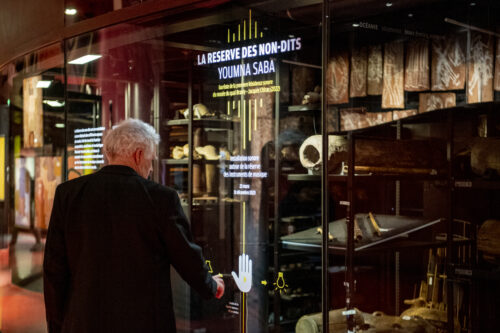
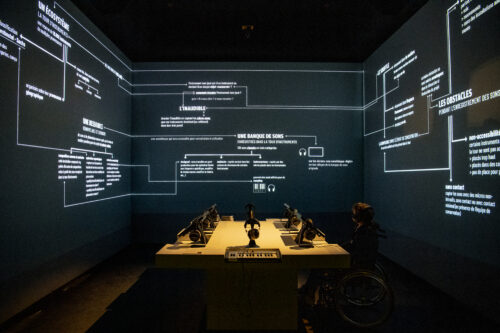

J’ai également conçu un espace dans « la boîte à musique » pour regrouper une synthèse des grands axes de ce travail dans la tour (notes et questionnements quotidiens). J’ai souhaité que cela fasse partie de l’installation, je voulais rendre tout cela accessible.
Sur les écrans apparaît une version allégée de la banque de données des 139 sons que j’ai sélectionné. Muni d’un casque, le visiteur choisit l’instrument qu’il veut écouter. Chaque enregistrement est une trace à l’instant T du phénomène sonore qui a pu être enregistré il y a 6 mois, et non pas l’instrument lui-même. J’en ai même gardé les interférences, comme le passage par exemple d’un groupe scolaire et le changement que cela a occasionné dans le son continu. Je n’ai pas souhaité le silence absolu, car je trouve que tout cela fait partie de l’état actuel de ces instruments et qu’il est important de capter cela aussi.
Sur le plateau du musée, j’ai utilisé ces sons pour en faire des compositions et créé cinq points d’écoute. Ces compositions sont basées sur des petites histoires que j’ai eu en faisant les enregistrements. La première chose que m’a racontée l’équipe des conservateurs, c’est que parfois dans le silo, au passage des chariots, les gongs commencent à bouger. En effet, il y a beaucoup de mouvements à cause des planches métalliques qui créent parfois comme un orchestre de gongs. J’ai recréé ce phénomène sans toucher aux gongs. On a juste touché à l’étagère, mis une petite pression et les gongs se sont mis à bouger et à cogner entre eux. J’ai capté cela et je l’ai gardé tel quel comme composition. Une autre est une composition de fréquences que je n’avais pas perçues à l’oreille, mais découvertes lors des tests de captation. Quand je plaçais mon micro-contact sur des instruments de percussion métallique, je n’entendais rien dans le casque. Mais lors de la post-production au Fresnoy, on a trouvé des fréquences qui traînaient dans le fichier; on les a isolées, boostées! Et j’ai composé avec cette matière.
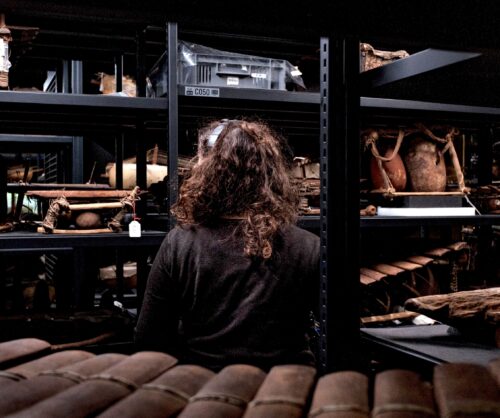

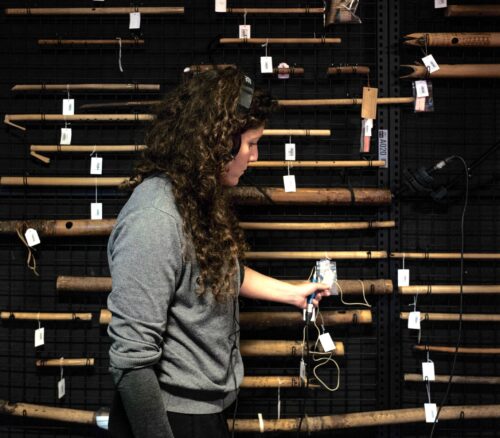
Ce silo renferme 10.000 instruments « inertes ». Qu’est-ce qui, selon vos mots, est de l’ordre de l’inaudible et comment procédez-vous pour le révéler?
YS : Au début donc je n’avais pas accès à la tour, c’était de l’ordre de l’imagination et je me basais sur le fait physique qu’il y a quelque chose même si ce n’est pas audible. Par exemple, j’imaginais des craquements de matière ou je comptais sur la caisse de résonance des instruments parce que je savais qu’ils auraient une empreinte acoustique spécifique.
Mais la première chose qui m’a surprise quand j’ai pu accéder à la tour, c’est la présence d’une soufflerie qui a rendu les sons encore plus inaudibles! Impossible d’entendre les craquements. L’inaudible, c’est aussi visuel. Quand on voit quelqu’un jouer de la guitare sans son, on peut imaginer qu’il y a un son. Le mouvement de l’air dans la tour, le mouvement des gens autour du silo font qu’il y a ces résonances et il faut les repérer avec les micros,
EDV : Je souhaiterais ajouter quelque chose sur cette question de l’inaudible en utilisant mon ancienne casquette de directeur de musée de la musique. Cet inaudible d’une collection d’instruments est toujours là, on est toujours en train de lutter contre et le public aussi le demande : “on veut entendre les instruments, pourquoi ne les joue-t-on pas?” Ou encore, “ce sont des instruments morts”.
Parfois, on joue certains instruments, on fait des fac similés ou des enregistrements mais on ne fait pas de concerts. Il existe toutes les optiques possibles en fonction du type d’objet.
Youmna ouvre une autre voie pour approcher les instruments.
Quand le visiteur clique sur un instrument, il s’attend à entendre un son de flûte, mais non, c’est autre chose qu’il entend. C’est une approche tout à fait originale et innovante. De plus, je suis aussi très content qu’avec les équipes, elle ait réussi à créer ce côté live car ce que l’on entend autour du silo a lieu en temps réel. Et cela s’ajoute au travail enregistré. Les deux utilisations sont importantes.
En 2020, dans le cadre du projet Taïma au CNCM Césaré à Reims, vous avez été accompagnée par Nicolas Canot (informatique musicale et lutherie électronique). Cela a-t-il eu une incidence dans la conception de cette installation?
YS : Oui tout à fait. Ce projet est une suite à la recherche commencée avec Nicolas pour créer de l’électronique avec un Oud. J’ai eu l’idée de placer un micro dans l’instrument, de travailler et jouer avec la résonance, comme élément musical, alors que d’habitude c’est un obstacle. J’ai fait ensuite un projet avec le Neue Vocalsolisten où j’ai placé mon Oud face à six chanteuses et chanteurs qui, en chantant, ont déclenché la résonance de l’instrument. J’ai fait cette même expérience à la Cité de l’Architecture où j’ai placé le Oud dans une pièce, et moi dans une autre, puis j’ai déclenché par ma voix le larsen du Oud. Ce projet au musée est une suite de cette expérimentation sur des modulations, des résonances en fonction d’un stimulus externe. Quand j’ai vu les instruments dans le silo, je me suis demandé : comment vont-ils résonner quand ils seront stimulés ? J’avais un plan B pour les stimuler, qui était de faire entrer des sons du dehors, mais je n’en avais pas besoin parce qu’il y avait des évènements qui se passaient dedans.
Vous dites que vous avez conçu ce projet comme une invitation au public, à une nouvelle forme d’écoute. J’aimerais bien que vous essayez de la définir?
YS : En soit c’est une écoute attentive, car je trouve qu’on perd cela. Quand on écoute ces sons pour la première fois, on perçoit de prime abord des sons continus, mais en fait, il y a des choses qui se passent dedans et c’est là l’intérêt de cette écoute. C’est l’écoute de l’autre aussi, celle de ces objets.
CD : Je trouve que cela crée aussi une pause dans un parcours classique, autant qu’on puisse dire que le parcours du quai Branly soit classique. Quand on lit les cartels, on est dans une démarche de visiteur lambda, mais tout à coup, on est happé par un son qui nous oblige à changer de registre. C’est une écoute attentive, en effet, mais c’est aussi une manière de rêver un peu, cela nous relance pour la suite du parcours, comme pour nous réalimenter et créer une suspension.
EDV : Je ne sais pas si c’est au niveau de l’écoute ou du concept, mais cela donne effectivement un sens différent à ce silo. On peut dire que symboliquement, il y a tous les instruments du monde, toutes les musiques du monde, donc toutes ces vibrations du monde.
Youmna, en quoi ce projet fait-il le lien entre votre recherche en tant que musicologue et votre création musicale?
YS : Dans ma création musicale, il y a toujours une recherche musicologique pour explorer des tempéraments différents, les interactions de certains intervalles, des fréquences. Dans le projet Taima je me suis intéressée à la langue arabe chantée et aux phonèmes de cette langue. Les phonèmes sont des timbres qui interagissent aussi avec les résonances. Ce projet de résidence m’a ouvert à beaucoup de questionnements. Par exemple, au sujet du tempérament des flûtes que j’ai découvertes, je ne savais pas qu’elles étaient accordées comme cela ; ces rapports de fréquences, de texture sonore, entre elles dans le même son. Cette bande sonore, j’ai hâte de l’utiliser dans mes créations parce que ce sont vraiment des sons qu’on ne peut pas recréer et qui sont spécifiques à cette matière et à ces objets. Je suis toujours à la recherche de sons un peu inédits.
Propos recueillis par Anne-Laure Chamboissier
Photos © Musée du quai Branly – Jacques Chirac, photos Julien Brachhammer
Photos © Vincent Mercier
Photos © Eric Sander



)
